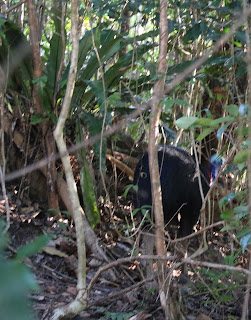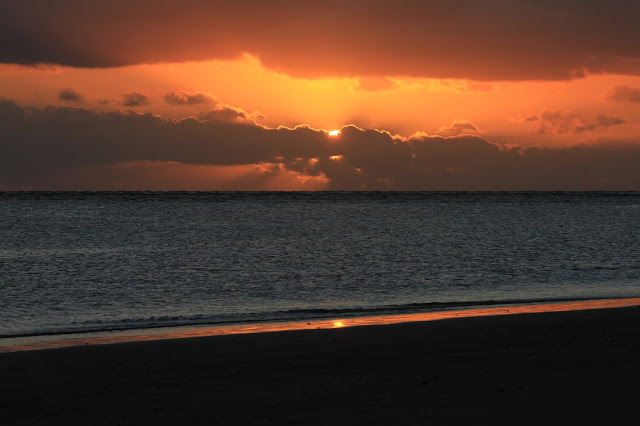Last week a cassowary with an extreme limp was seen walking into my property. Although I searched it was not until Wednesday that I found the injured cassowary, it was Gregory. I could see a wound on his leg but it appeared to have dried and the wound closed, by then he was only limping slightly. I spoke to the Cassowary Hot Line and sent the EHP officer photos of the bird's injury. I asked the officer to have Grahame Lauridsen, the cassowary vet, access the wound from the photos, meanwhile I offered to continue to monitor Gregory and report to EHP if I thought the cassowary was deteriorating. EHP officers asked me to continue monitoring the cassowary.

It is lucky that several palms in the nursery are dropping fresh seed and Gregory came into the nursery to eat them every day, so it was easy to keep an eye on him.
Today I noticed the wound looked dry and was not seeping at all. His limp has almost gone and he seems to be eating well and starting to get some colour back in his wattles. I will make a full report to EHP on Tuesday and hope by then cassowary Gregory will be fully recovered.
I do not know what caused the injury to cassowary Gregory's leg, however, it is most likely to have been from either a motor vehicle or a dog. I did hear a dog barking loudly on the afternoon I believe the incident occurred to Gregory.
Since then, two week ago, not once have I have sighted juvenile cassowary Ky, I am concerned for his safety.
Just before he was in the nursery drinking water, much to the delight of three men from Vanuatu. Gregory had a drink then walked slowly away.
Cassowary Jessie's hormones are raging and I was privileged to witness an encounter between Jessie and Snout when I found her stalking Snout on Friday afternoon.


No aggression was displayed by any of the cassowaries. Snout walked away from Jessie with the chick Kin close behind. Kin did not appear to be frightened by Jessie and did not utter any alarm whistles. Occasionally Kin looked back at Jessie who is, I believe, his mother.
Snout walked towards the nursery gate then turned into the rainforest on the eastern side of the road. Kin followed his dad and Jessie went in after them. Again Jessie was very calm and displayed no aggression to Snout or Kin.



 I walked around the area and came in from behind and discovered the three cassowaries were sitting down. Occasionally, little Kin gave a low whistle. Kin was sitting with his back to Jessie and Snout.
I walked around the area and came in from behind and discovered the three cassowaries were sitting down. Occasionally, little Kin gave a low whistle. Kin was sitting with his back to Jessie and Snout.Snout watched Jessie as she lowered and turned her head. When she did this the blue colour on her neck flashed brightly amongst the green and brown leaves of the forest. Only at these moments could I actualy see her.

 Snout sat upright with no movement and watched Jessie intently as she swirled and lowered her head.
Snout sat upright with no movement and watched Jessie intently as she swirled and lowered her head.
Coyly, Jessie sat lower on the forest floor and every now and again she raised her head to look at Snout. The only sound was the occasional low whistle from Kin.

Then Snout stood up and walked away with a knowing sideward glance at Jessie. Little Kin stayed close to his dad.
Jessie remained sitting for another twenty minutes then walked out across the road and into Lot 27V. Earlier Snout had walked away in the opposite direction.


I caught a glimpse of cassowary July several times this week. When she saw me she walked away quickly.


A wide range of seed in the cassowary scats over the last couple of weeks. This shows there is plenty of food available in the rainforest.
Below two black-tailed godwits right and two bar-tailed godwits left. Thank you Del Richards for the confirmation of the ID.
Below the bar-tailed godwit on the left is giving lip to the godwit in front. I found it amazing that the bird's beak had the flexibility and muscle control to be raised. Whatever 'the lip' conveyed they engaged in a little dance followed by preening.
The godwits added a whole new meaning to 'giving the lip'.

It was good to see so many godwits feeding on the beach. Most of them will move on to other feeding grounds further south.



I have not seen the banded grey-tailed tattler I photographed last week, however there are other tattlers on the sand flats that look as if they are going to stay for the season.
Lesser and greater sand plovers and little red-capped plovers are feeding mostly at the water's edge.


In the hollows of the sand-ridges, out of sight until they are disturbed, dozens of red-necked stints hunt for crustaceans.

Whimbrels and common sandpipers join in the fishy feasting.

The only terns feeding in the river at the moment are the gull-bills, the crested have all disappeared. The gull-billed terns line the very outer sand-bar and as the tide swells they shift further and further in towards the beach, jostling for a position on each new sandbar.
As I returned on dusk Wednesday night, Mt Bartle Frere was etched in Bartle-blue against the lemon sky. It was the most wonderful sight and even though the tide was racing in I stopped to take a photo.
It was approaching dark when I reached Crocodile Creek and the water was running in fast. I stopped breathless, against the darkness of the mangroves three Rajah Shelducks were feeding amongst the mangrove roots.

 I watched them as they walked along the banks of the creek. They went into the water and swam to the other side up the bank and disappeared into the dark of the mangrove forest. I have seen these ducks around the estuary before but it is always a marvellous sight to watch them in this environment.
I watched them as they walked along the banks of the creek. They went into the water and swam to the other side up the bank and disappeared into the dark of the mangrove forest. I have seen these ducks around the estuary before but it is always a marvellous sight to watch them in this environment.The tide was racing in and the water was over my knees as I crossed the creek and returned home.


The next morning I went for a walk at first light and as I walked out onto the beach I saw the pelicans take off from the Coquette Point Spit.
Seven pelicans, some alone some in pairs, flew in different directions for their day's outing.
Then from across the top of the mangrove forest five Rajah Shelducks flew out and landed on the beach in front of me. At sometime between dusk and dawn another two ducks had joined the team.
They immediately started to drink water from the river.
As I rounded the Spit, in the haze before dawn, I saw the 28,000 ton HMAS Canberra anchored off Thompson Point. The Gull-billed terns filled the sky in the foreground as they departed the estuary for a day's foraging in the hinterland.



HMAS Canberra is on exercise off Cowley and Brampton Beaches at the moment. There is constant helicopter traffic along the coast while this exercise continues.
That is why I particularly needed to be up early to see what birds had arrived on their migratory journey. Once the helicopters start moving the birds disperse.
The morning light changes from pink to yellow then brilliant orange when the sun rises above the clouds. The birds stir and the air is full of their calls.

As I walked back along the beach I saw the Coral Explorer head up river. This little boat has just started doing tours on the Johnstone River and looks idealy suited for the job. If you are interested their Facebook page is https://www.facebook.com/snappingtours
Dianne Mauloni, Secretary Johnstone Region Landcare Group Inc., on Thursday organised a field outing to the nursery for a group of young naturalists. The kids explored the beach, ran down fiddler crabs and learnt about the various mangroves and the role they play in the ecology of the shoreline.
With great enthusiasm the children hunted for rubbish and much to their disgust they found a heap of old fishing line, bottles and a knife left behind by fishermen.
The kids have a strong message for fisherman. "Please take home your rubbish. Old fishing line can kill shorebirds, turtles and other marine creatures."

 The children learnt about the strangler figs of the rainforest. They found out the story behind the big anchor which was left in the mangroves when the sugar barge the 'Kataoka' went aground on the rocks off the beach eighty years ago.
The children learnt about the strangler figs of the rainforest. They found out the story behind the big anchor which was left in the mangroves when the sugar barge the 'Kataoka' went aground on the rocks off the beach eighty years ago.After morning tea the children explored the Mandubarra Turtle Rehabilitation Centre with Henry and Alan Epong. A special thank you to Henry and Alan for teaching the kids about turtles.
You are all great kids and a big thank you for cleaning up the beach and a special thank you to Dianne Mauloni and Jill Fells for mentoring the group.
It was very disappointing to see the interpretative sign at the end of Coquette Point Road vandalised once again. I have run out of words for what I think of this person or persons.
New tourist enterprises like the 'Coral Explorer' rely on information like this for their passengers. It is such a great shame when we were provided with a beautiful sign by the Wet Tropics Management Authority, to now see it on the ground....... again.

At the moment there are small flocks of the Pied Imperial pigeons flying to and from Flying Fish Point and across the Moresby Range National Park every day. In my observations the numbers here are not as high as in previous years but that may change as the breeding season starts.
A momentous occasion today when Tilau and Consy from the Tokelau Islands in the South Pacific were joined in marriage vows under the coconut trees along the sandy banks of the Johnstone River estuary. Consy and Tilau live in Townsville but they chose to marry in Innisfail as many of their relations live here. Tilau's parents flew to FNQ from Tokelau to witness the union. Some highlights from today's celebrations.


The very best wishes for your future Tilau and Consy.
Cheers for this week,
Yvonne.




 F
F








































No comments:
Post a Comment